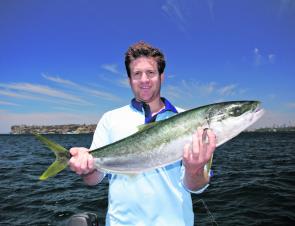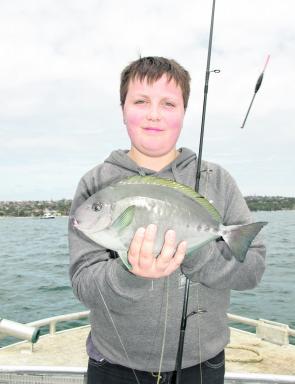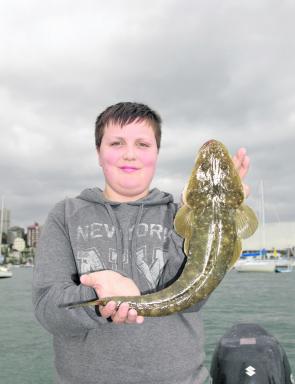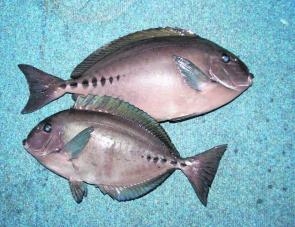The warm water was slow to come in this season but it has finally arrived with a vengeance and with it have come the kings.
There has been a good mix of fish from 2kg-10kg anywhere from the Heads to well upstream. Middle Harbor has produced some good fish from its various wrecks and rocky points and there have been schools of smaller kings up around Goat Island in the main Harbour.
North Head, Clarke and Shark islands, the ‘Cakes’ and the channel markers have all turned on the action at various times. Squid is the top bait, which is good because they have been abundant this season.
The Harbour has been producing some sensational surgeon fish action lately so I’ll take this opportunity to shed some light on this mystery fish.
Despite their abundance they are rarely ever seen by rec fishos. There are a few reasons for this.
They are weed eaters, which limits their availability to only luderick fishers.
They have very robust grazing teeth which nip easily through the light mono leaders used by luderick fishers and I estimate that half of all the surgeons we hook nip straight through the leader virtually the second you put the pressure on the fish.
To make matters worse, if they are lip hooked and are unable to bite through, they are dirty fighters, as bad as any king or GT, and half of them will run you into the structure and bust you off.
I’d bet that most of the bust-offs that luderick fishos attribute to drummer are actually surgeons.
They are rarely caught by ocean rock luderick fishers and seem to have a preference for the quieter waters of the harbours and bays. However, my friend Jack Hannan, who spends a lot of time snorkelling, tells me that they are common off the ocean rocks but are generally in deeper water out wide, putting them out of reach of the average luderick rig.
Given that all the surgeons we have caught have been on standard luderick methods and baits with a few luderick mixed in, it appears that it is very much a location thing.
The only hint I can give you in this respect is to look for either white rock (bald sandstone boulders grazed clean by sea urchins) or vertical structures like sharp reef edges or jetties in deep water.
Surgeons are mighty powerful fish, with 1kg specimens a real challenge on standard blackfish gear. According to the Australian Museum website ‘sawtail surgeonfish (Prionurus microlepidotus) can be recognised by grey to brownish coloration and the row of five to six black scutes on the rear of the body. It grows to 70cm long.
Adults are found mostly on coastal rocky reefs. Juveniles are usually seen in estuaries and coastal bays.
This species occurs in tropical and temperate waters of the Western Pacific. In Australia it is known from northern Queensland to southern NSW and Lord Howe Island.
The tail scutes are scalpel-sharp which, I imagine, is where their name came from. The flesh is pearl white and delicious.
The dorsal and anal fin spines are hideously sharp and can inflict painful wounds.
Surgeons have mouths almost identical to luderick (even in tooth structure) and their skin is closer to shark skin than anything else.
As for catching them, all as I can say is that we do what we normally do for luderick. You might consider upping the tackle a bit if you intend to fish specifically for surgeons and as I said, they are location-specific.
Try No 6 long-shank hooks but make sure to cover the entire shank with weed. They are nowhere as abundant or widespread as luderick but they obviously do mix.
When prospecting for them I strongly recommend that as well as your standard float rig, you fish cabbage bait close to the bottom off a paternoster rig, because surgeons mostly sit deeper than luderick.
They are caught in water as shallow as 3m but are much more common in the 6m-12m. Given that we rarely present weed baits in these sort of depths it’s not surprising that surgeon fish are uncommon captures for recreational fishos.
Who knows what else we might discover fishing deep weed bait? Red morwong and old maids (scats), both vegetarians, are two very real possibilities.
There is no size limit for surgeon but there is a bag of five, mainly to protect them from spearfishos.
Flathead have been on the chew and the average size is well up on previous years, thanks to four years of no commercial fishing.
Nearly all our flattie fishing is done with lures but they are viable targets on bait. If you choose dead bait like whitebait or prawns I suggest that you drift rather than anchor.
Flatties hide buried to the eyes in the sand so you need to take the bait to them. They are not in the habit of roaming around looking for food but are one of the ocean’s greatest ambush predators. How many fish go to the trouble of burying themselves?
Live poddy mullet and small yakkas will put off enough flash and commotion to attract flatties from farther afield but even they will benefit from a drift. It’s all about covering ground and this is why lures are so successful.
The two key elements in finding flathead are to maintain contact with the bottom and cover lots of ground.
Let the lure sink right to the bottom. If you are using braid line and conditions are good you will be able to clearly detect when the lure hits bottom. Your line will be taut as the lure sinks but will drop slack with a noticeable bump when it hits bottom.
Your rod tip should be low and pointing straight down the line so that the rod continues on the same plane as the line.
Once the lure hits the bottom it’s time to immediately whip your rod upward in a series of three strikes until the tip is directly overhead. Now pick up the slack line that you have just retrieved with the rod by winding as fast as you can with the reel while lowering your rod tip quickly back down to its starting point near the surface.
Your lure will now be on its way back to the bottom after having been whipped up a couple of metres. Your line will again be taut and you are now watching for the bump and slack in your line as it touches down again.
Repeat the process all the way back to your feet. This is the standard retrieve for working the bottom for a whole range of species and it is critical that you perfect it if you are going to get the best out of your plastics.
Reads: 1763
There has been a good mix of fish from 2kg-10kg anywhere from the Heads to well upstream.

Surgeons are mighty powerful fish, with 1kg specimens a real challenge on standard blackfish gear.

Flathead have been on the chew and the average size is well up on previous years, thanks to four years of no commercial fishing.

Surgeons are nowhere as abundant or widespread as luderick but they obviously do mix and can be caught on the same tackle and bait.




